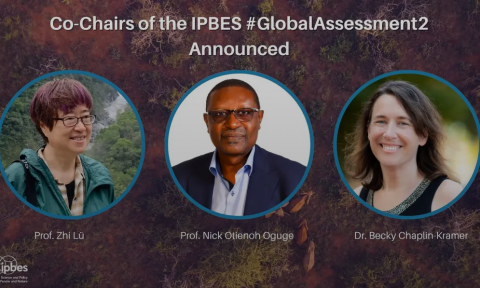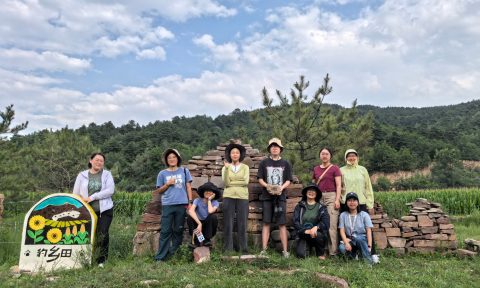China-Europe Policy Dialogue on OECMs Seminar was held in Beijing to discuss new approaches to biodiversity conservation
On May 15, 2025, the China-Europe Policy Dialogue on OECMs Seminar was held in Beijing to discuss new approaches to biodiversity conservation. The meeting delved into the new conservation tool known as Other Effective Area-based Conservation Measures (OECMs). Representatives from government departments, academia, conservation organizations, and international bodies, including experts and practitioners in the field of biodiversity conservation, participated in the seminar to contribute international experience and local insights for the implementation of OECMs in China.
 Seminar venue
Seminar venue
OECMs refer to areas outside the protected area system that achieve long-term and sustained conservation of biodiversity through effective governance and management. As an important complement to protected areas, OECMs have received widespread attention globally in recent years and play a significant role in achieving Target 3 (which proposes to conserve at least 30% of the world’s land, waters, and seas by 2030) of the Kunming-Montreal Global Biodiversity Framework (hereinafter referred to as the GBF), also well known as the “30×30” target.
This seminar, as the launching event of the OECMs policy dialogue project supported by the China Biodiversity Facility (CBF), which is funded by the European Union and implemented by Agence Française de Développement (AFD), was jointly organized by the Shan Shui Conservation Center and Peking University Center for Nature and Society, partnering with Tsinghua University National Parks Research Institute, the Chinese Academy of Forestry, the International Union for Conservation of Nature (IUCN), the Shan Shui Foundation, and the Agence Française de Développement (AFD). The China Biodiversity Facility (CBF) is an important platform for China-EU cooperation in the field of biodiversity, aiming to promote public policies and practices for biodiversity conservation in China through innovative demonstration projects and policy dialogues. Shan Shui Conservation Center and IUCN jointly implement the OECMs policy dialogue project supported by CBF, aiming at promoting the implementation of OECMs in China through the assessment of the current situation of OECMs in China, China-Europe policy dialogues, and international experience exchanges.
During the opening remarks, Shi Xiangying, Executive Director of Shan Shui Conservation Center, introduced the background of the CBF policy dialogue project and expressed the hope that this seminar would facilitate knowledge sharing and exchanges of practical experiences between China, Europe, and the international community regarding OECMs standards and mechanisms, and jointly explore the paths and strategies for the Chinese forestry and grassland departments to achieve biodiversity conservation targets, especially in the field of OECMs. Khalid Pasha, IUCN Asia Regional Office, Regional Coordinator, Protected, Conserved, and Heritage Areas, stated that countries around the world are actively promoting OECMs, and many Asian countries, including China, have begun to promote OECMs pilots and implementation through various means. He hopes that the China-Europe policy dialogue will facilitate experience exchanges and promote OECMs as a cornerstone of inclusive and effective conservation, contributing to the achievement of global biodiversity conservation goals.
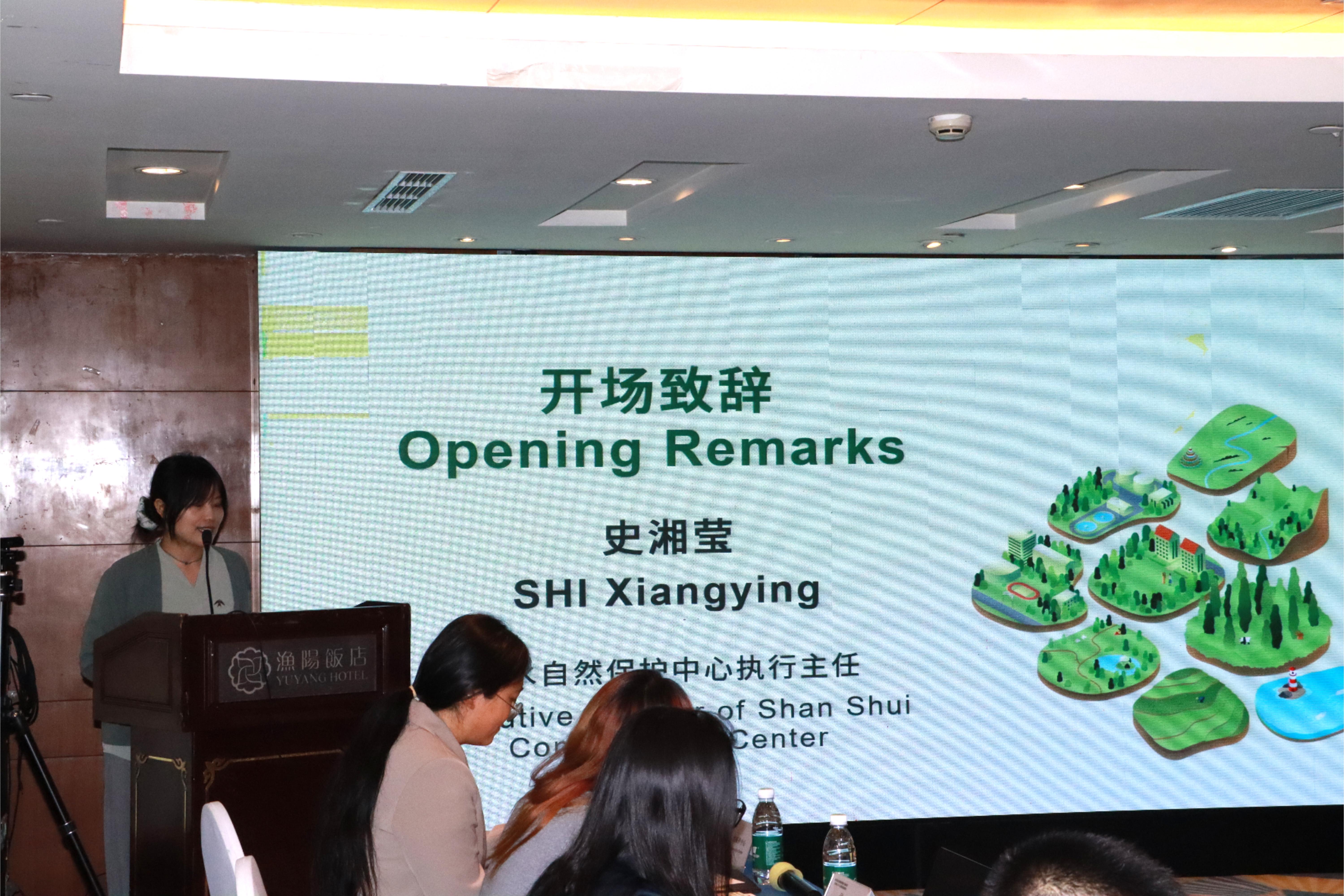
Shi Xiangying delivered opening remarks

Khalid Pasha delivered opening remarks
Focusing on the conservation gap, exploring the potential and pathways of OECMs in China
Professor Lu Zhi from Peking University pointed out in her keynote speech that although China’s current protected area system covers 18% of the country’s terrestrial area, there are still deficiencies in terms of the representativeness of ecosystem and species protection. She emphasized that OECMs, as an important supplement to the protected area system, have the potential to fill these gaps through more inclusive conservation approaches towards human activities, especially in the densely populated eastern regions. She further analyzed the policy gaps and opportunities for OECMs. Prof. Lu then introduced the purpose, activities and deliverables, and how partners will collaborate in delivering them under the OECMs policy dialogue project, expressing the hope for joint efforts to promote the establishment of OECMs standards and mechanisms tailored to China’s context through a series of work including conservation gap analysis, status analysis, case studies, policy recommendations and dialogues, and international exchanges in this project.

Lu Zhi delivered keynote speech on OECM needs, challenges, and prospects in China
In China, the forestry and grassland authorities play a significant role in biodiversity conservation, undertaking responsibilities for the management of forest, grassland, wetland, desert ecosystems, protected areas, and terrestrial wildlife. Zhang Yan, Head of IUCN China Office, based on a review of China’s area-based conservation policies for biodiversity outside protected areas, analyzed and discussed the potential types of OECMs in the forestry and grassland authorities’ jurisdiction (such as key wildlife habitats, ecological public welfare forests, and important wetlands) and their huge potential, as well as the role of OECMs in enhancing the connectivity of the conservation network, promoting the participation of multiple stakeholders, and achieving equitable governance.
 Zhang Yan introduced potential types of OECMs in the forestry and grassland authorities and their potential
Zhang Yan introduced potential types of OECMs in the forestry and grassland authorities and their potential
Associate Researcher Zhao Linlin from the First Institute of Oceanography, Ministry of Natural Resources, focused on marine ecosystems, discussing the particularities and complexities of marine ecosystems from ecological and management perspectives. He proposed identification criteria for marine OECMs in China and shared the progress and future plans of the work on identifying and analyzing marine OECMs.

Zhao Linlin presented the identification of marine OECMs in China
Exchange of experiences between China and Europe to jointly promote policy and mechanism innovation
Khalid Pasha, IUCN Asia Regional Office, Regional Coordinator, Protected, Conserved, and Heritage Areas, and Marine Deguignet from IUCN Global Team for Protected and Conserved Areas, shared the current status of international and Asian OECMs, emphasizing the importance of integrating OECMs into the broader terrestrial and marine landscapes through conducting spatial conservation prioritization planning. They also shared key experiences such as enhancing community trust, encouraging cross-sectoral cooperation, enabling policies and longevity of OECMs, and establishing governance structures, based on IUCN’s series of global and Asian efforts in supporting the development of OECMs.

Khalid Pasha discussed the importance of OECMs
Heather Bingham, Senior Programme Officer of the United Nations Environment Programme World Conservation Monitoring Centre (UNEP-WCMC), gave an introduction to the protected planet platform and World OECM Database (WD-OECM). Based on WD-OECM data, she examined the increase in conservation coverage, KBA coverage, and protected and connected area coverage brought about by OECMs globally and in Europe, and expressed expectations for further promoting the identification and reporting of European OECMs in the future. She suggested that when developing OECMs in China, attention should be paid to important biodiversity values and long-term conservation effectiveness, and incentive mechanisms should be explored to encourage the participation of all parties in OECMs.

Heather Bingham introduced protected planet platform and WD-OECM database
Olivier Hymas from University of Lausanne, Switzerland, and IUCN WCPA Europe OECMs focal point, further explored the challenges faced by Europe in promoting OECMs, such as the misunderstanding that OECMs offer less protection than protected areas, the complexity of existing toolkits, and the lack of recognition for community conservation actions. He also emphasized the opportunities brought about by European restoration laws, inclusive conservation approaches, and inter-regional exchanges. He shared a good example from Scotland, where community participation and local knowledge were effectively utilized, setting a valuable precedent for Europe and other countries.

Olivier Hymas shared issues and challenges of OECMs in Europe
Establish a multi-stakeholder participation mechanism to jointly promote the implementation of OECMs
During the roundtable discussion session, the participating guests engaged in a lively discussion on two topics: “China-Europe OECMs Policy Dialogue” and “Pathways for OECMs in Forestry and Grassland Authorities”.
In the roundtable discussion on “China-Europe OECMs Policy Dialogue” moderated by Shi Xiangying (Executive Director of Shan Shui Conservation Center), Chinese and international experts, including Khalid Pasha (IUCN Asia Regional Coordinator, Protected Conserved and Heritage Areas), Olivier Hymas (IUCN WCPA Europe OECMs focal point, University of Lausanne, Switzerland), Terry Townshend (Consultant at Paulson Institute), Jin Tong (member of IUCN OECM China Expert Working Group), Wang Wei (Researcher at Chinese Research Academy of Environmental Sciences), and Guo Hongyu (Deputy Director of Greenovation Hub), had in-depth exchanges and shared on issues such as how to involve non-state actors in OECMs, the role of the government, incentive mechanisms, effectiveness evaluation, and conservation connectivity. They agreed that the development of OECMs requires the joint efforts of multiple parties including the government, local communities, social organizations, enterprises, and the public, and also needs innovation in OECM’s localized name and the establishment of effective incentive mechanisms (recognition, fundings, etc.) and supporting policies, in order to promote OECMs to play a better role in connecting the conservation network and achieving long-term conservation.

“China-Europe OECMs Policy Dialogue” roundtable discussion
During the roundtable discussion on the “Pathways for OECMs in Forestry and Grassland Authorities” moderated by Lu Zhi (Professor at Peking University), Chinese biodiversity experts, including Luo Ming (Researcher at Land Consolidation and Rehabilitation Center, Ministry of Natural Resources), Guo Yinfeng (Researcher at Marine Disaster Reduction Center, Ministry of Natural Resources), Fang Zhi (Former Deputy Secretary-General of China Environmental Protection Foundation), and Liu Wenhui (Senior Engineer at Chinese Research Academy of Environmental Sciences), jointly explored how to better combine the top-down and bottom-up approaches in promoting the development of OECMs in China. They discussed the important role of OECMs as an opportunity and lever to promote the mainstreaming of biodiversity in all government departments and social sectors, using this as a means to mobilize and encourage more social forces to participate in biodiversity conservation under the guidance and support of the government.
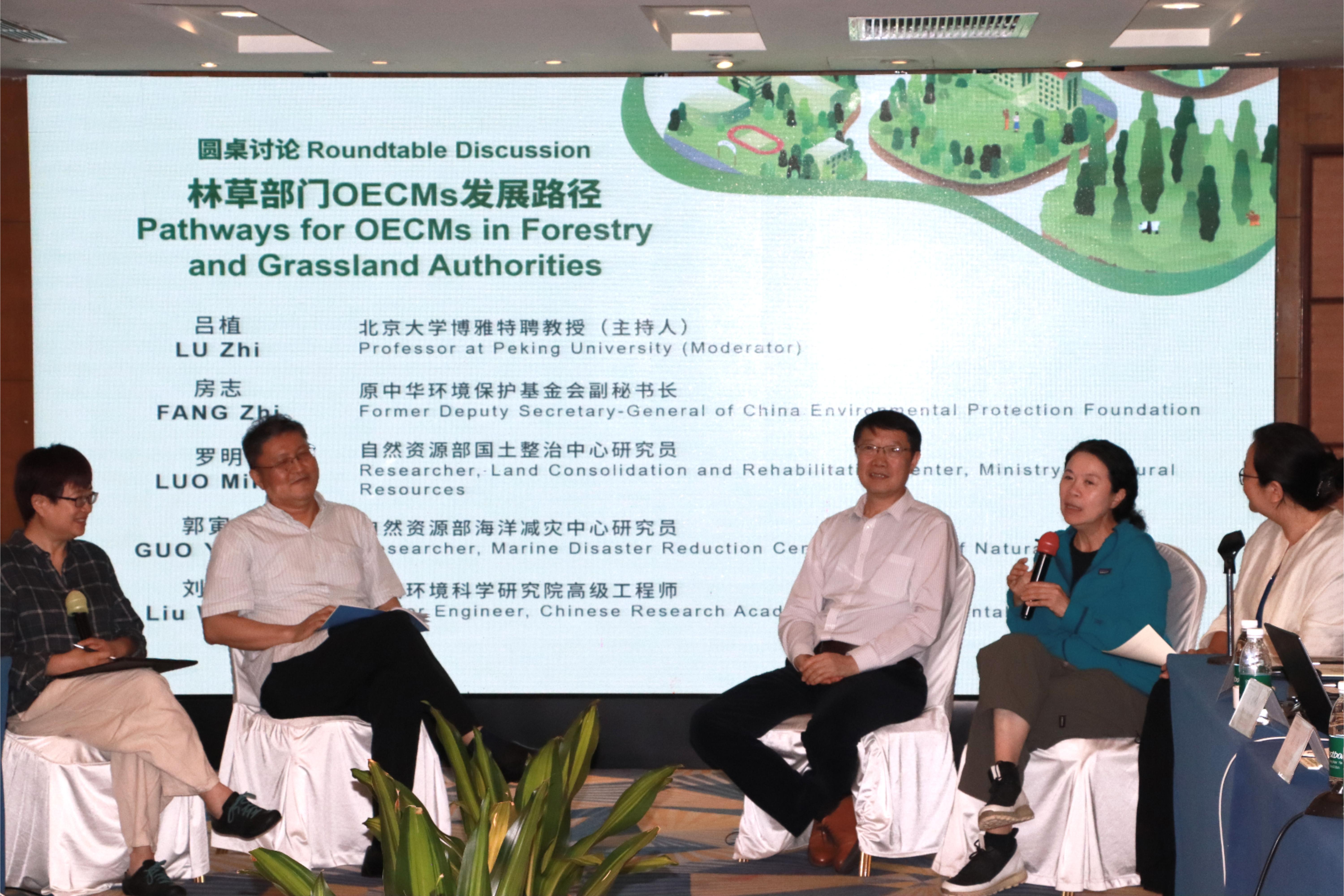
“Pathways for OECMs in Forestry and Grassland Authorities” roundtable discussion
This seminar has effectively promoted the exchange and sharing of experiences in OECMs between China and international counterparts. It has also delved into potential pathways and strategies for OECMs in China, and enhanced understanding and recognition of OECMs among participants. These outcomes have provided valuable insights for advancing the development of OECMs in China. Moving forward, it is hoped that through the continuous implementation of the OECMs policy dialogue project, we can further analyze the current status and potential of OECMs in China, strengthen national and international policy dialogues and experience exchanges on OECMs, and jointly promote the development and implementation of OECMs in China, contributing to the realization of the GBF 30×30 Target.
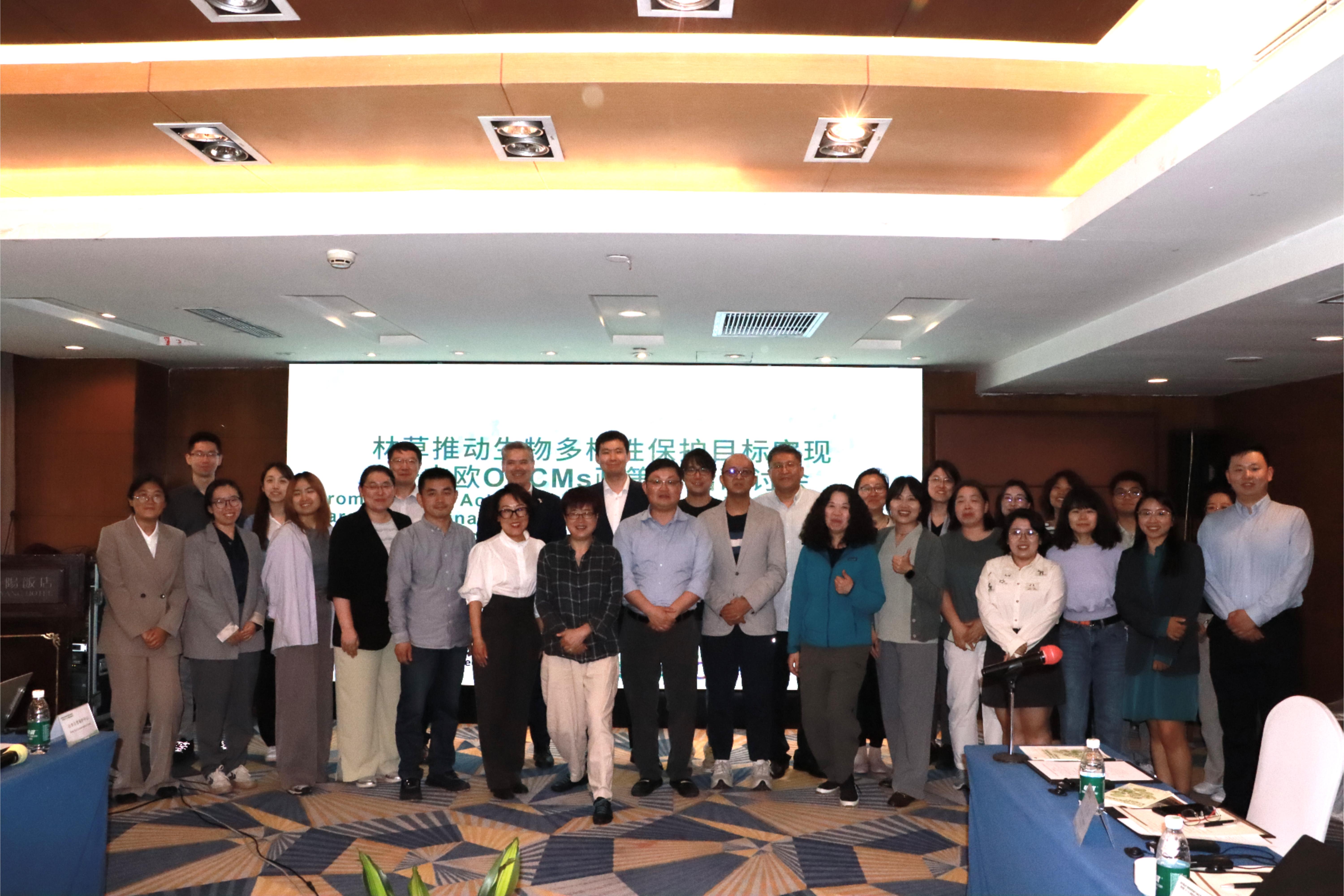
Group photo of the seminar

